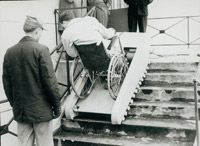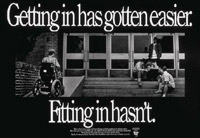Legislation
The Disability Rights Movement is distinguished by the activism shown by the huge number of participants and by the legislative steps that have led to gradual improvement in the rights of people with disabilities. Legal changes show the evolution in attitudes toward disabilities over time and the acceptance of people with disabilities as citizens of the United States.
President John F. Kennedy signed Public Law 88-164 into law in 1963. The law required that students with disabilities must be educated. This laid the foundation for future reform in education for students with disabilities. Five years later the Architectural Barriers Act ordered that all federally funded and constructed buildings must be accessible to people with disabilities.

A man in a wheelchair climbs a staircase with the aid of a ramp that moves up the steps with him.
Accessibility is not achieved in any one particular way. Designers have crafted numerous solutions to make buildings open to as many people as possible, proving that human ingenuity can break down physical barriers and open up society to everyone.
Courtesy of Post-Polio Health International
The Rehabilitation Act of 1973 marked the first piece of federal legislation that dealt directly with discrimination against people with disabilities. It prohibited any organization that received federal funding from discriminating against people with disabilities. Although it affected only federally funded programs, the act was a major stepping stone toward future legislation, since it established compliance boards. In the 1980s the act was threatened by the Reagan administration, but overwhelming lobbying by grassroots organizations halted the obstructive efforts of the administration.
In 1975, the Education for All Handicapped Children Act (Public Law 94-142) was passed, establishing the right of children with disabilities to be educated alongside children without disabilities. Schools were required to create individualized education plans (IEPs) for students with disabilities to ensure each child had the proper learning environment.
People with disabilities were added to the ranks of those protected by federal fair housing laws in 1988, under the Fair Housing Amendments Act. This established minimum standards of access for new multiple-dwelling housing facilities. For the first time, housing developers were required to comply with basic principles of adaptable design.

Protesters ride with Justin Dart Jr. and Max Starkloff in a St. Louis march through the streets. Many of the protesters use wheelchairs.
Justin Dart Jr. and Max Starkloff head up a march through the streets of St. Louis. Justin Dart Jr. undertook a cross-country crusade to campaign for the passage of the Americans with Disabilities Act, stopping in many cities and marching with local activists. He revisited many of the same cities in 1995 to celebrate the success of the ADA, stopping in St. Louis.
Courtesy of Max and Colleen Starkloff-Starkloff Disability Institute
The groundwork for the Americans with Disabilities Act (ADA) was laid through all the previous legislation. Housing, employment, education, and funding had all been addressed, but a higher level of protection and better programs were still needed. The first draft of the ADA was introduced in 1988 by Representative Tony Coelho and Senator Lowell Weicker. At this time, major campaign efforts by advocates like Justin Dart Jr. kicked off to support passage of the act.
On July 26, 1990, the Americans with Disabilities Act was signed into law by President George H.W. Bush on the White House lawn as thousands of disability rights activists watched. As the most comprehensive legislation on disability rights, the act gives full rights of citizenship to people with disabilities. The ADA sought to eliminate discrimination in all aspects of life: employment, services rendered, places of public accommodation, transportation, and communication.
Since the passage of the ADA, numerous court cases and laws have been argued to clarify the provisions of the act. In 2008, the Americans with Disabilities Act Amendments Act (ADAAA) broadened the definition of a disability to allow for more people to be covered by the original act.

A wheelchair user enters a building by way of a ramp while a group of people sits on the steps a distance away. The caption of this poster reads "Getting in has gotten easier. Fitting in hasn't."
This Easter Seals poster reflects on changes since the passage of the ADA. Many physical barriers have been removed and people with disabilities can interact in society, but the attitudes of some people still keep people with disabilities separate.
Courtesy of Easter Seals
There are still a great many barriers that need to be broken down. Through legislation, major changes have been enacted in the physical world. Now, the greatest changes to come must be in the attitudes of society toward people with disabilities.
Sources: "Brief History of DRM" Colleen Starkloff; The ABC-CLIO "Companion to The Disability Rights Movement;" San Francisco State University "Chronology of the Disability Rights Movement;" EDGE Education for Disability and Gender Equality "The ADA;" The Americans with Disabilities Act
Missouri History Museum exhibition
Americans with Disabilities Act: 20 Years Later.
June 26, 2010
to Jan 8, 2012
